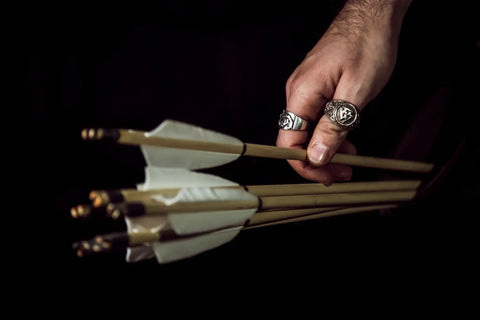Your Cart is Empty
Menu
-
- Shop by Type
- End of Line Sale Items
- New In
- Viking Gifts Under $30
- Hand Forged Axes
- Silver Viking Jewelry
- Stainless Steel Jewelry
- Cremation Jewelry
- Necklaces and Pendants
- Hand Carved Wooden Pendants
- Kings Chains
- Viking Drinking Horns
- Pendant Chains
- Rings
- Bracelets
- Earrings
- Beard Beads and Beard Rings
- Collectables
- Ceramic Mugs
- Street Wear
- Horn Jewelry
- Bronze and Pewter Jewelry
- Shop by Theme
- Viking Axe
- Celtic Jewelry
- Dragon or Serpent
- Viking Raven
- Wolf / Fenrir
- Rune Jewelry
- Odin Jewelry
- Ram / Goat
- Shieldmaidens / Lagertha
- Sword, Spear or Arrow
- Thor's Hammer / Mjolnir
- Tree of Life / Yggdrasil
- Helm of Awe / Aegishjalmur
- Triquetra or Triskelion
- Valknut / Knot of Slain
- Vegvisir / Viking Compass
- Veles / Bear
- Blogs
- Help
-
- Login

Exploring The History Of Viking Rings: From Medieval Treasures To Modern Inspiration

From King Solomon’s magical ring to the Elizabeth Taylor diamond, throughout the ages rings have long represented great societal shifts and major historical events, but when it comes to the rings of medieval civilisations, the true history of some of the world’s most beautiful jewelry can be obscured. For instance, the Vikings were the wearers of some of history’s most exceptional rings, with intricate designs carved into metals that withstood war, weather and woe. When we walk in the footsteps of the Vikings, we discover an elaborate history, with stories that can be told through rings alone.
In this article, not only will we be discussing what made Viking rings so unique, but we’ll also be tracing their history from the medieval world right up to today, where these delicate pieces decorate the hands of hundreds of Nordic history enthusiasts.
Journey Into A Medieval World
To truly understand the significance of Viking rings, and the role they played in Norse culture, we must first go back in time to a Medieval world - one that was ruled by powerful, seafaring Norsemen whose heroes included Ragnar Lothbrok and Cnut the Great. Known for their fierce and effective military tactics, which allowed them to dominate both in battle and while raiding, the Vikings introduced new battle tactics, the likes of which had never been seen before.
From shield walls, in which warriors would interlock their shields to create a wall of defense, to a feigned retreat in which they would lure and entrap enemies before turning to pounce, the Vikings sure knew how to hold their own in battle. However, their tribal success and bold lifestyle are reflected not just in their victory triumphs, but also in the artistic culture that was fostered during this period. One of the key factors? Jewelry.
The Vikings were skilled craftsmen who created beautiful and intricate jewelry pieces from precious metals, most notably the Viking arm ring.
The Viking Arm Ring
Typically made from silver and decorated with intricate designs, the Viking arm ring is one of the most recognisable pieces from the Medieval period. Arm rings were not just a piece of jewelry; they held great significance and represented much more than personal style - in the Viking Age, they were also a form of currency that could be used for trade, especially between the Vikings and the Sami people of northern Scandinavia.
These arm rings were also a way to show one's allegiance or dedication to a particular leader or clan, which was vitally important in a society where loyalty was highly valued, and alliances could make or break one's position.
Viking Finger Rings
While the arm ring was a large piece that made a bold statement, the Vikings also used finger rings to tell their story and highlight their symbolic beliefs. These rings were often believed to have protective qualities, and others were worn as a symbol of a particular god or goddess. For example, rings featuring the image of Thor's hammer were believed to bring protection and good luck to those who were devoted to him.
These rings were typically made of bronze or silver and were often decorated with simple designs, such as knotwork or animal motifs. Viking finger rings were often worn by both men and women, and were sometimes used as wedding rings.
Viking Ring Making Techniques
Interested in how the Vikings crafted their rings? Here are three of the most popular methods:
Filigree
To craft their jewelry, the Vikings blended methods new and old, taking inspiration from as early as the time of ancient Mesopotamia! Filigree, a technique that involves the twisting or braiding of thin wires of gold or silver into intricate patterns to be soldered onto the surface of a ring, was one of the most popular Nordic styles, and can still be seen on modern adaptations today.
Granulation
Granulation is another technique that was used regularly in the making of Viking jewelry. This involves creating small, granular beads of metal and fusing them onto a surface, before arranging the beads in specific patterns to create beautiful designs that can be adapted based on the needs of a tribe.
Repoussé
Designed to create a raised edge at the front of a ring, repoussé is a technique that the Vikings relied heavily on for some rings, as it allowed for detailed designs to be effortlessly added to the surface of a ring from the reverse side, which in turn offered more space to properly represent a god or tribe.
A Modern Day Spin On Viking Rings
Even in modern times, Viking rings are still popular, both for their historical significance and their unique designs. In fact, the rings worn by Nordic tribes are actually growing in popularity in the modern age - many jewelers create Viking-inspired rings that pay homage to the craftsmanship and symbolism of the original Viking pieces.
One popular design for modern Viking rings is the Valknut symbol, which features three interlocking triangles and is believed to have been a symbol of the god Odin who is often associated with death and the afterlife. Have you spotted the Valknut symbol on any Viking jewelry pieces yet?

How To Style Viking Rings Of Your Own
If you're interested in styling Viking rings of your own, there are a few things you can do to create a unique and personal look:
Choose the right materials: Viking rings were typically made from materials such as silver, gold, bronze, and iron, so choosing a material that speaks to you and fits your personal style should be your number one priority. Try a sterling silver option if you want a ring that is durable and long-lasting without compromising on style.
Incorporate traditional Viking motifs: Viking art is known for its intricate knotwork, animals, and geometric shapes, so if you want to go for a truly authentic look, consider adding some traditional motifs to your design.
Customize the ring size and shape: Viking rings were often chunky and large, but if this isn’t your style then you don’t need to worry. You can customize the size and shape to fit your personal preferences, perhaps by opting for a thinner ring band or a different shape. You can even find serpent shaped rings that are perfect if you’re looking for a piece that’s a little less overwhelming to wear, but still a great conversation starter.
Consider gemstones or other embellishments: While traditional Viking rings didn't always include gemstones or other embellishments, you can add these elements yourself to create a unique look. Consider adding a small gemstone in a color that complements the metal, or incorporate other materials like leather or wood for a unique take on Viking jewelry that still allows you to feel close to your Viking heritage.
Ultimately, the key to styling your own Viking ring is to draw inspiration from traditional Viking art and materials, while also incorporating your own personal style and preferences. By staying close to the history, and learning more about who the Vikings were and how they used their jewelry, you can become the most confident version of yourself when you wear your new artwork, and channel the Viking within.
